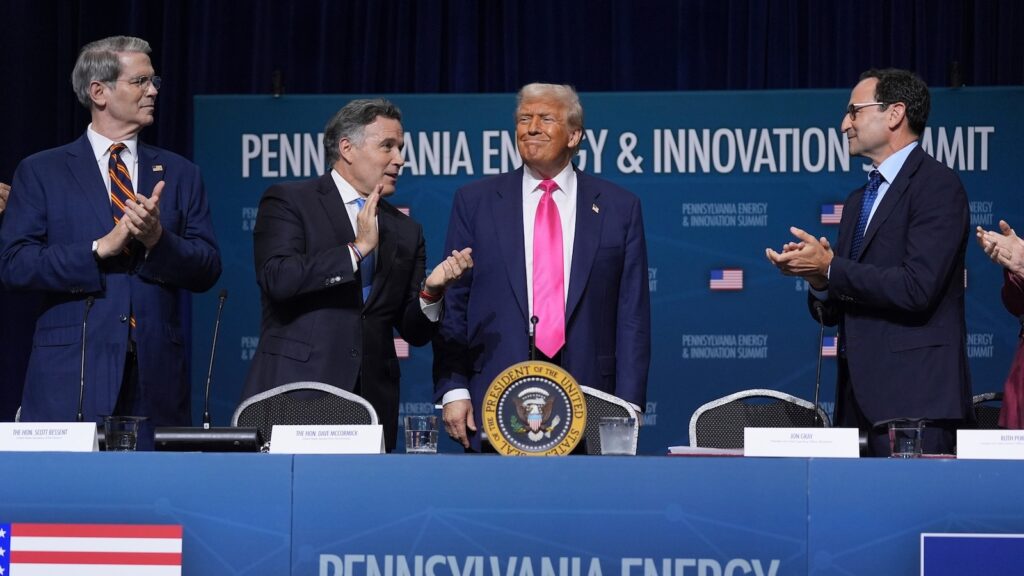President Donald Trump’s tariffs tanked markets and unleashed recession forecasts when the president unveiled sweeping levies little greater than 100 days in the past. Now, as Trump continues to tout the coverage, the financial system is buzzing alongside and Wall Road is responding to every new tariff with a shrug.
A latest spherical of tariff threats has added a brand new layer of uncertainty, however the monthslong monitor report affords economists a possibility to guage what the tariffs have yielded up to now.
Analysts who spoke to ABC Information credited the tariffs for delivering higher-than-expected tax income and serving to to elicit some commitments from corporations bent on investing in new manufacturing within the U.S.
However, some analysts cautioned, these firm commitments carry a very long time horizon and wiggle room for companies to renege upon the spending because the tariff coverage fluctuates. In the meantime, tariffs have began to push up some costs, risking a bout of inflation that would damage customers and disrupt the financial system, they mentioned.
Trump has rolled back lots of his steepest tariffs over latest months, together with a sky-high levy on China, the highest supply of U.S. imports. In latest days, nonetheless, Trump announced plans to slap tariffs as excessive as 50% on dozens of nations, together with 25% tariffs on prime U.S. commerce companions corresponding to Japan and South Korea.
In all, customers presently face an efficient tariff fee of 20.6%, the very best since 1910, the Yale Budget Lab discovered this week.
The Trump administration touts tariffs as a part of a wider set of “America First financial insurance policies,” which have “sparked trillions of {dollars} in new funding in U.S. manufacturing, expertise, and infrastructure,” based on the White Home’s website.
In principle, levies on imports incentivize companies to construct manufacturing within the U.S. as a method of averting the tax burden.
Scores of corporations have pledged new funding within the U.S., together with tech giants Apple and Nvidia, pharmaceutical corporations Merck and Johnson & Johnson in addition to automakers Hyundai and Stellantis, the White Home says.
“The entire concept is to encourage reshoring of producing and alter the stability of commerce. That might all have some optimistic impression,” Morris Cohen, a professor emeritus of producing and provide chains at Duke College, advised ABC Information.
Firms face the selection of creating expensive, long-term funding choices amid Trump’s on-again, off-again tariff insurance policies, which the White Home has altered quite a few occasions since Trump took workplace, some analysts mentioned.
A pair of courtroom rulings in Could thrust a few of the tariffs into authorized limbo, including one other layer of uncertainty as federal appeals courtroom judges decide whether or not a serious swath of the insurance policies go authorized muster.
“The businesses making guarantees are attempting to politically take care of Trump,” Matias Vernengo, a professor of economics at Bucknell College, advised ABC Information, including that he expects many companies will finally fall wanting their commitments.
“It might be good if he introduced a tariff coverage and caught to it. However that’s not what’s occurring,” Vernengo added.
The Trump administration has rebuked criticism of its tariff strategy, saying the pliability affords White Home officers leverage in commerce negotiations with international locations focused by the levies.
President Donald Trump holds up a chart whereas talking throughout a “Make America Rich Once more” commerce announcement occasion within the Rose Backyard on the White Home, April 2, 2025.
Chip Somodevilla/Getty Photographs
The tariffs, in the meantime, have yielded a burst of tax income as importers to pay the federal authorities once they carry focused items into the U.S. The U.S. recorded about $27 billion in tariff-related tax income final month, bringing complete funds up to now this yr to greater than $100 billion, Treasury Division knowledge confirmed.
Mark Zandi, chief economist at Moody’s Analytics, mentioned tariff income might exceed $300 billion by the tip of 2025, which might quantity to almost 1% of U.S. gross home product. That income might assist ease authorities deficits, some analysts famous.
“The tariff revenues are extra substantial than I anticipated in the beginning of the yr,” Zandi mentioned, noting that tariff ranges had remained greater than he anticipated.
Nonetheless, Zandi voiced skepticism concerning the endurance of the tax funds.
“It might not be prudent for lawmakers to rely on this income sooner or later, as it’s unclear whether or not the tariffs will stay in place given they could be discovered to be unlawful or future Presidents could resolve to decrease or eradicate them below government order,” Zandi mentioned.
In the meantime, the U.S. financial system up to now has defied analysts’ fears of a giant, tariff-induced value spike. Nonetheless, tariffs contributed modestly to the rise of inflation final month, analysts previously told ABC Information, citing the value hikes in product classes made up primarily of imports.
Shopper costs rose 2.7% in June in comparison with a yr in the past, matching economists’ expectations however marking an uptick from a month earlier. Nonetheless, the inflation fee clocked in beneath the three% recorded in January, the month Trump took workplace.
The worth of toys — a product dependent virtually fully on imports — elevated six occasions quicker in June than it had simply two months prior. Generally imported merchandise like garments, furnishings and mattress linens had been additionally among the many items that jumped in value.
Vernengo, of Bucknell College, mentioned tariffs would possible push up inflation for a short lived interval, placing strain on the Fed to maintain rates of interest elevated and in flip threat an financial slowdown.
“Costs will go up as Trump imposes tariffs. Then, as tariffs are established and costs regulate themselves, they may cease rising,” Vernengo mentioned. “It’s the Fed’s response that may matter extra for my part than the tariffs.”

